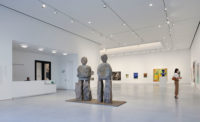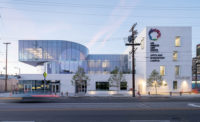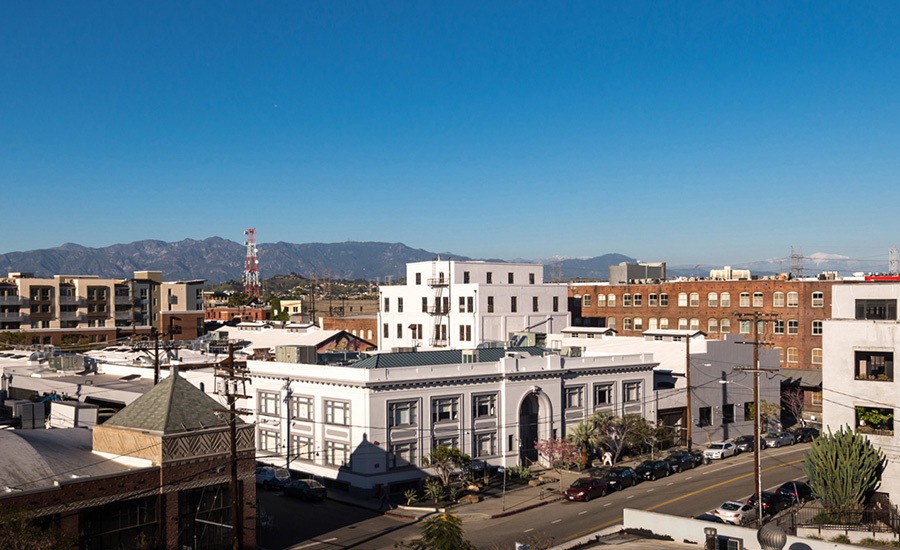Gigantic Hauser Wirth & Schimmel Gallery Opens in Former Los Angeles Warehouse
The art gallery, designed by Creative Space and Selldorf Architects, reveals a broader shift in Downtown L.A.’s urban fabric.

Hauser Wirth & Schimmel Gallery, Los Angeles
Exterior View
Photo © Joshua Targownik

Hauser Wirth & Schimmel Gallery, Los Angeles
Exterior View
Photo © Joshua Targownik

Hauser Wirth & Schimmel Gallery, Los Angeles
Exterior View
Photo © Joshua Targownik

Hauser Wirth & Schimmel Gallery, Los Angeles
South Gallery
Photo © Joshua Targownik

Hauser Wirth & Schimmel Gallery, Los Angeles
North A Gallery
Photo © Joshua Targownik

Hauser Wirth & Schimmel Gallery, Los Angeles
Courtyard
Photo © Joshua Targownik

Hauser Wirth & Schimmel Gallery, Los Angeles
Breezeway
Photo © Joshua Targownik







Architects & Firms
The newly opened Hauser Wirth & Schimmel gallery, the latest addition to the Downtown Los Angeles Arts District commercial boom, is a behemoth, occupying all 116,000 square feet of a former Pillsbury flour mill complex.
The gallery’s arrival prompts obvious comparisons to Manhattan’s Chelsea arts district, where such powerhouse galleries also occupy the disused spaces of a once-overlooked neighborhood. There, Hauser & Wirth inhabits a former disco roller rink that architect Annabelle Selldorf converted into a gallery in 2013, with another Selldorf-designed, ground-up space on the way.
Although Selldorf Architects has designed four of Hauser & Wirth’s six international locations, the gallery assigned the design of its first L.A. outpost—to be run by former MOCA chief curator Paul Schimmel—to the in-house architect of its real estate broker Creative Space L.A. Working directly under Schimmel, with Selldorf as consultant, they approached the project with a light touch, focusing on the preservation and restoration of a site that had been left derelict for the past two decades.
Even in its dilapidated state (35 tons of asbestos needed to be removed), the site had obvious potential in its soaring, interconnected buildings—former barrel storage units, processing facilities, the employee bank, and repair shops for distribution trucks, each with soaring ceilings.
The site also allowed the gallery to stretch its legs, both in its curatorial approach and architectural program. Hauser Wirth & Schimmel outfitted itself with amenities more typical of a museum than a gallery, services that include a bookstore, a forthcoming restaurant, and—like all contemporary museums of late—spaces for informal gatherings in the form of a soon-to-open public garden, and a sprawling, 6,000-square-foot central courtyard.
Visitors can enter the building from either the north- or south-side entrances, which connect via Selldorf’s primary contribution, a 362-foot-long breezeway that acts as a central, open-air corridor to the adjoining spaces. For the most part, the architects maintained the cosmetic and structural features that allude to the building’s previous life, including the concrete floors, rusted and patinated surfaces, and exposed bow trusses.
One exception is a pair of galleries installed in the column-free spaces at the north end of the complex, outfitted with art-exhibiting standards like humidity control and white temporary drywall. The other is the pristine, double-height, regally-columned former bank space on the south end of the complex that houses both exhibition and administrative space. The sunshine filters in from an existing gabled skylight. Selldorf’s mastery of natural lighting, a hallmark of her gallery work, has been described as “sublime” and “auratic,” but that effect is noticeably absent here; with only the existing skylights and newly installed street-facing windows covered in UV filters, the other galleries seem dimly lackluster in comparison.
There is plenty of light, however, in the sprawling event space of the central courtyard where the wooden roof has been peeled away from the steel bow trusses. The architects left a roof on the perimeter to cast a few dappled shadows to allow your eyes to adjust to the L.A. sun, although you may still want to bring your sunglasses.
The speed at which the neighborhood is developing is equally blinding; What took decades to build in Manhattan’s Chelsea neighborhood is being recreated in L.A.’s Arts District at a breakneck speed. “It’s an extremely speculative environment,” says Creative Space partner Geoffrey Annenberg, who also previously brokered local property for New York gallerists Michele Maccarone and Gavin Brown. “As soon as this project was announced, half our calls were from clients who wanted to build in its orbit.” These clients often hail from London, San Francisco, and New York, cities where the real estate market has become notoriously unlivable. One of them is Hotel Americano, a Chelsea hotel scheduled to open its L.A. location next door to Hauser Wirth & Schimmel in 2018.
The economic impact in the area is palpable; real estate prices have doubled in the past year alone, according to Annenberg, to about $6 per square foot in a typical retail space on the Arts District’s main thoroughfare. It’s a bargain compared to the $60 per square foot being charged in retail spaces in Chelsea—but it seems the second coming of the great California Gold Rush is already afoot.



.jpg?height=200&t=1713468361&width=200)






